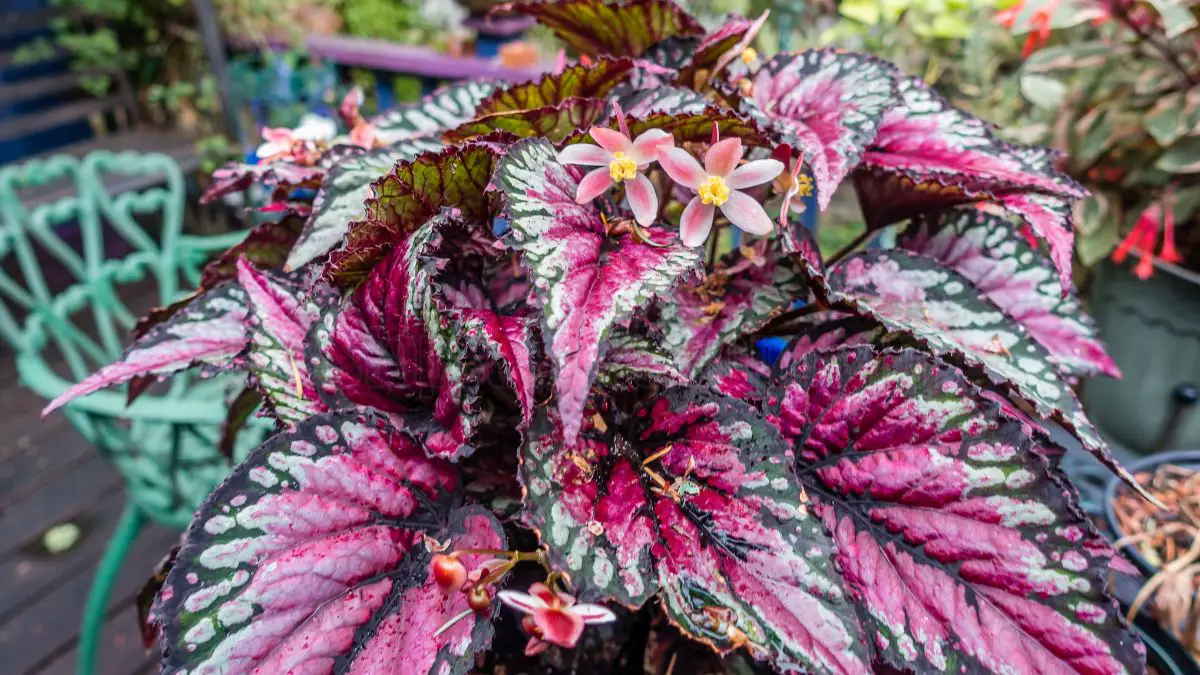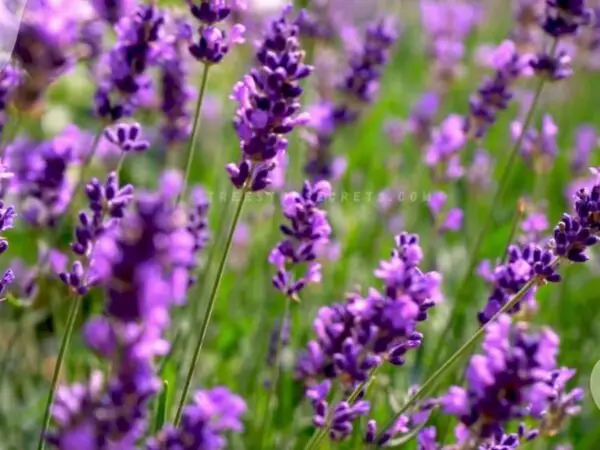Proper rex begonia care will ensure that they stay healthy and produce their signature, eye-popping foliage. These beautiful plants prefer bright, indirect light, which is perfect for most interiors, especially with the warm climate of Marrakech. Keeping humidity on the higher side is important since these plants like a damp habitat. Using a pebble tray will do the trick.
Provide extra humidity. Spraying your rex with water regularly will keep it happy, but you need to make sure that the roots aren’t sitting in water. Fertilizing them during the growing season encourages them to grow lush, and frequent leaf cleaning wards off any pests.
By learning about these basic needs, you can ensure that your rex begonias stay healthy and vibrant, bringing a stunning beauty to your home.
Key Takeaways
- Give your rex begonias plenty of bright, indirect sunlight for the best growth and color. Rotate your plant once a week for even light exposure and supplement with grow lights in the winter if needed.
- Growing rex begonias in a peat-based potting mix mixed with perlite or orchid bark for extra drainage works well. Replenish the soil every 2-3 years to keep nutrient levels high.
- Rex begonias prefer moderately moist soil, so water them when the top inch of soil dries out. Supplement to change humidity and seasons. Supplement to increase humidity. Monitor leaf health for indications of over or under watering.
- Keep temperatures at 60°F to 70°F and raise humidity levels by misting or using a humidifier. Prevent exposure to cold drafts to ensure the longevity of your plant.
- Provide a balanced liquid fertilizer at two-week intervals during the active growing months. During winter months, reduce or stop feeding to avoid excess nutrient accumulation.
- Keep a close eye out for pests and diseases, treating with insecticidal soap or neem oil as needed. Better air circulation keeps away a lot of other common problems.
Optimal Conditions for Rex Begonias
Creating optimal conditions for rex begonias is essential for their growth. These easy houseplants thrive in a humid environment, allowing their striking leaves to flourish and maintain good health, ultimately leading to vibrant colors and lush foliage.
Ideal Light Levels for Growth
Rex begonias love high, filtered light. Keeping them close to a window where they receive indirect light is best to avoid leaf scorching.
Consistently moving the plant around ensures all sides are getting balanced light on a regular basis. During winter, when natural light might be hard to come by, adding grow lights can help fill their requirements.
Monitoring leaf color is key—striking colors are a sign that they have the right amount of light.
Best Soil Composition and Potting Mix
Well-draining, fluffy potting mix is extremely important. A peat-based potting mix blended with perlite or orchid bark creates the drainage and aeration that’s key to their delicate root system.
Heavy soils usually retain too much water, leading to root rot. To avoid this issue, replace the potting mix every two years or so.
Watering Frequency and Signs of Stress
Water when the top inch of soil is dry to the touch. Wilting, drooping or yellowing foliage are warning signs that your plant is not happy.
Changes in the season will affect how often you need to water, and a moisture meter can help you monitor it accurately.
Temperature and Humidity Preferences
Consistent temperatures in the range of 60°F to 70°F is best. Raise humidity, ideally in the 50% range or higher, which can be done with a humidifier or a water tray close by.
Frequent misting helps with increasing humidity.
Propagation Techniques for Rex Begonias
Propagation of rex begonias can be a simple and satisfying process that allows you to increase your plant inventory. This process can be done using several techniques from division, water propagation and leaf cuttings. No matter which technique you choose, you’ll be able to grow new plants and take pleasure in the process of passing along these colorful gems.
Sanitary tools are a must to avoid spreading infectious diseases. By taking the step to use sanitized scissors or knives, you help ensure healthy growth for your new plants. Choosing healthy parent plants will set you up for success and improve your chances of successful propagation. The last ingredient is patience, as rooting can take 4-6 weeks.
1. Division Method Explained
Start by gently extracting the plant from its container. Carefully pull apart the rhizomes, taking care to do little injury. Plant each division in its own container.
Fill with new potting mix, preferably a mixture of peat moss and perlite, for best results. Once you’ve repotted, give each new plant a good watering to settle them into their new surroundings. Monitor the divided plants carefully for any indication of transplant shock.
2. Water Propagation Steps
In water propagation, after making a clean cutting from a healthy leaf, dip the end of the cutting in rooting hormone to encourage root growth. Put the cutting in a glass of water so that the stem is in the water but the leaf is not.
Change the water every few days to keep it fresh. Roots should form within three to four weeks, at which time you can move the cutting into soil.
3. Leaf Cutting Method Success Tips
When propagating with leaf cuttings, choose mature leaves that exhibit healthy tissue. Cut the leaf into wedges or sections.
Cut an X shape about ½-inch long across five or six of the largest veins on the bottom side. Put the cuttings in a warm, humid location, and maintain consistently moist soil (not waterlogged) until they begin to show signs of new growth.
Common Pests and Diseases
Rex begonias, though beautiful, can be prone to numerous pests and diseases that may affect their vibrant leaves. By understanding the common issues, plant parents can ensure proper care, allowing their houseplants to flourish in the right conditions.
1. Identifying Common Pests
Mealybugs and spider mites are frequent pests. Underneath the leaves and along the stems are areas to check very thoroughly.
Spider mites usually produce a very thin webbing. If you see white, cottony spots on the leaves, those are probably signs of mealybug feeding.
A second red flag is sticky residue on leaves, a sure sign of aphids. A jeweler’s loupe or magnifying glass will make it easier to identify these tiny pests.
2. Diseases Affecting Rex Begonias
Fungal infections can be an unwelcome surprise as well. Powdery mildew is recognized by a white, powdery fungus covering leaf surfaces.
Botrytis appears as gray mold, especially in high humidity. In addition, look out for bacterial leaf spot, which appears as dark, water-soaked lesions on leaves.
Proper watering techniques are key to reducing these disease hazards.
3. Effective Treatment Solutions
To resolve these problems, use insecticidal soap or neem oil as a natural pest control method. If you have a fungal infection, such as powdery mildew, use a systemic fungicide.
To decrease disease spread, it’s important to rake infected leaves and dispose of them by burning or bagging. Proper sanitation methods—cleaning tools, pots, etc—make it less likely that one will come back.
With close observation and prompt treatment, you can help your rex begonias thrive and impress for seasons to come.
Seasonal Care Adjustments
Seasonal care adjustments are key for promoting the best health for your rex begonias, which are popular houseplants known for their stunning colors and variegated leaves. As temperature patterns and daylight change, our practices need to adapt by watering and fertilizing differently to prevent issues like leaf crinkling, ensuring these beauties thrive all year long.
Indoor Care Throughout the Year
Regular watering and humidity are important for rex begonias grown indoors. Keeping humidity levels around 50% to 70% helps reduce leaftip curling. Especially during the winter months when daylight is scarce, using artificial lighting can make all the difference in promoting growth.
Routine inspections for pests and diseases are imperative, but even more so as the seasons change. Removing any dead or damaged leaves helps improve airflow and allows your plant to focus on growing healthier foliage.
Outdoor Care Considerations
For outdoor rex begonias, keeping them in a shaded spot will help shield them from the late-day sun and prevent wilting. In extremely hot summer conditions, keep an eye on humidity levels and make sure your soil is properly moist.
With colder weather inevitably rolling in, keeping these beauties safe from frost is essential, whether that means bringing them inside or utilizing plant covers. In extended dry periods, watering more often encourages soil to retain moisture, keeping plants healthy and preventing stress.
Adapting to Seasonal Changes
Changing watering frequency with seasonal temperature and humidity makes a big difference. Taking the time to gradually transition indoor plants to outdoor conditions in the spring will help to prevent shock and encourage acclimatization.
As winter comes, limiting light exposure and water intake will help your plant get ready for a dormancy period. By seeing how rex begonias do with these adjustments, we’re learning how to better care for them. This results in a vigorous and flourishing plant.
Addressing Common Issues
Even experienced gardeners can run into issues when it comes to caring for rex begonias, making a swift solution all the more essential. Recognizing these common issues is the first step in preserving the health and beauty of your plants. Keeping a close eye on your plants will ensure that you can identify any warning signs as they develop and take action before it’s too late.
Maintaining a checklist of common complications can help to focus your troubleshooting efforts, helping to simplify the process when changes in care are needed. Taking notes on how your plants react to various changes will help you learn what best suits their care.
1. Solutions for Wilting Leaves
Wilting leaves can be a sign of watering problems. Check to make sure you’re not watering too much or too little. If your soil is consistently wet, cut back on how often you water.
On the other hand, if it’s dry, water more to rehydrate the plant. Increasing humidity around the plant will help reduce stress caused by low humidity. Don’t forget to use a humidifier or a pebble tray to maximize your success!
This is an important part of plant maintenance, as it directs the plant’s energy and resources toward healthier leaves. Make sure your rex begonia isn’t being subjected to temperature extremes or drafts, which can cause wilting.
2. Managing Leaf Loss and Softness
When dealing with issues of leaf loss and/or softness, first look to identify the cause. Whether it’s pests, diseases, or environmental stressors, something could be happening.
Water consistently to avoid extremes, and ensure your plants are getting proper lighting conditions to help give structure to the leaves. Monitoring humidity levels can be important, too, to raise humidity when necessary to help prevent leaf loss and softness.
3. Diagnosing Nutrient Deficiencies
Needle yellowing or leaf mottling, or poor growth are classic symptoms of nutrient deficiencies. Keep an eye out for these symptoms and test your soil’s pH and nutrient levels.
Change your fertilizer regimen to address the nutrients you need to add. Adding in organic compost can help to replenish soils, boosting overall nutrient content and availability.
Pruning and Leaf Care Techniques
With proper rex begonia pruning and leaf care, you can elevate your houseplants to the next level, ensuring they look healthy and beautiful. Routine pruning is critical for maintaining your plant’s shape and promoting bushier growth, making it an essential practice for plant parents and enthusiasts alike!
1. Best Practices for Pruning
For best results, prune your rex begonia throughout the growing season, preferably in spring or early summer. Concentrate on clearing out older leaves, which may obstruct new foliage.
When you prune, always prune above a node, so there is healthy regrowth. To keep pests away, after pruning, remove the material from the site.
2. Leaf Care to Prevent Disease
Keeping leaves clean is really important. Wipe leaves regularly, especially for container plants, to remove dust and debris that can attract pests.
Don’t water from above, which leaves the foliage moist and more susceptible to disease-causing fungus. Air circulation is important.
Humidity is a big no-no, so make sure your begonia is well spaced from neighbors to avoid humidity pockets. Monitor your plant regularly for any signs of disease and promptly prune or remove any infected leaves.
3. Encouraging New Growth
To encourage new growth, ensure even lighting and humidity levels. Consistent fertilization throughout the growing season encourages robust growth.
To promote lushness, pinch back the tips of stems to instigate branching, resulting in a bushier plant. Watch for root binding and repot as needed to give new growth a chance to thrive.
Environmental Differences in Rex Begonia Care
How the Environment Affects Rex Begonia CareKnowing how the environment affects your rex begonia’s care is key to keeping it thriving.
Indoor versus outdoor cultivationIndoor and outdoor settings pose different challenges to breeders and growers, necessitating different approaches to effective cultivation.
1. Indoor vs Outdoor Growing Conditions
Illumination levelsIndoors, people tend not to be as sensitive about lighting conditions. In an indoor environment, rex begonias do best in filtered light, and in an outdoor environment, they enjoy bright, indirect sun.
Temperature is an issueOutdoor plants experience greater swings, so they require close observation. In nature, rainfall does a lot of the work, so rex begonias growing outside may not require as much effort on your part.
With indoor plants, a more regimented routine means over-watering is more likely to result in root rot sooner. Pest pressures are different; indoor plants may face fewer pests, but they are still at risk for becoming infested by pests such as spider mites.
Outdoor plants are subject to much more diverse pests, like aphids, slugs, and scale.
2. Adjustments for Different Environments
Watering needs to change based on how humid your spot is. Dry indoor conditions in the winter months will mean houseplants will need more frequent watering than plants kept outside where they can take advantage of natural rain cycles.
To protect plants in the garden, protective coverings when conditions are too hot or too cold are needed. By trying out different potting mixes, you can determine the best mix for your environment that improves drainage but allows for adequate nutrient retention.
By paying close attention to how plants are reacting to their environment, it becomes easy to adjust care routines to keep plants happy and thriving in any location.
Conclusion
We hope that taking care of your rex begonia can be the start of a long and exciting exploration. These plants thrive in the right conditions, so remember to give them bright, indirect light and keep the soil moist. Monitor for pests and be ready to change care based on the changing seasons. When problems arise, easy solutions are usually all that is needed. Proper pruning will ensure that they always look their best while promoting vigorous growth.
Providing the right care will ensure that, with a little extra attention and TLC, your rex begonia will thrive and bring stunning color to your indoor garden. Take an artistic approach to this experience, get curious about your plant, and appreciate all the beautiful colors it adds to your world. Begin your rex begonia care adventure today, and enjoy the beauty of a flourishing plant.
Frequently Asked Questions
What are the ideal light conditions for Rex Begonias?
Rex Begonias thrive best in bright, indirect light, as this allows their stunning variegated leaves to flourish. Placing them next to a window with filtered sunlight is ideal; however, direct sun can cause leaf crinkling and burn their delicate foliage. Ensuring proper light conditions is essential for these beautiful houseplants to thrive.
How often should I water my Rex Begonia?
Water your rex begonia once the top inch of soil becomes dry to the touch, typically every 5 to 7 days. Ensure the pot has adequate drainage to prevent water logging, as this can lead to issues like leaf crinkling in these popular houseplants.
What temperature do Rex Begonias prefer?
Rex begonias thrive in warm temperatures, making them ideal houseplants for room environments. Avoid placing them in drafty areas or locations with fluctuating temperatures, as this can shock the delicate leaves of the rex begonia.
How do I propagate Rex Begonias?
To propagate rex begonias, simply cut a healthy leaf from the plant and place it in either water or fresh soil, ensuring it remains humid and moist. Roots will develop in a few weeks.
What are common pests affecting Rex Begonias?
What are common pests affecting rex begonias? Plant parents should check their houseplants often and use insecticidal soap or neem oil to eliminate infestations before they become severe.
How can I fix yellowing leaves on my Rex Begonia?
Yellowing leaves are a symptom of overwatering or insufficient light for your rex begonia. To improve its health, reduce waterings and ensure it receives adequate light while removing old dead leaves.
When is the best time to prune Rex Begonias?
When is the best time to prune rex begonias? This practice promotes fuller, bushier growth and clears away any unsightly or unhealthy leaves, helping to keep your houseplants looking their best and healthiest.
Image Source: Paid image from CANVA





